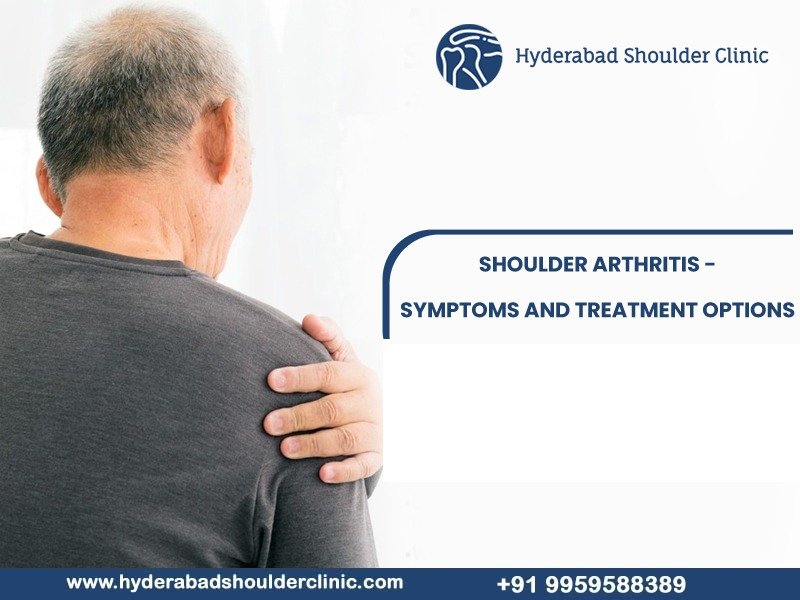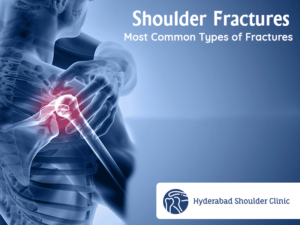Shoulder arthritis means inflammation around the shoulder joints causing pain and stiffness. The patient will find it difficult to lift their arms. The shoulder arthritis can occur at the main joint which is the “ball and socket” joint also known as the glenohumeral joint. But it could also occur at the second joint i.e. where the collarbone (clavicle) meets the acromion on your shoulder blade known as the acromioclavicular joint or AC joint.
Long-standing arthritis leads to cartilage loss which is the tissue that covers the humeral head and the “socket” of your shoulder joint.
If left untreated the bones in the joint rub directly against each other.
What are the symptoms of shoulder arthritis?
- The most significant symptom is mild-to-severe pain and stiffness in your shoulder. Slowly the patient will lose range of motion, especially if the glenohumeral joint is involved.
- The pain will be significant when trying to reach overhead, lift heavy objects or play sports that involve a range of arm movements.
- Long-standing arthritis will make simple everyday tasks such as bathing, grooming and writing or using your computer painful.
- If the pain is at the side of your shoulder, it likely involves your glenohumeral joint.
- If the pain is at the top of your shoulder, it likely involves your acromioclavicular (AC) joint.
- Grinding, or cracking in your shoulder joint: Due to the loss of cartilage, the bones are rubbing against each other while moving the shoulder leading to noises.
- Difficulty in sleeping: Due to the shoulder pain, sleep becomes difficult. It would be better to sleep on your back, with a pillow under the elbow of your affected side. Sleeping like this gives shoulder support and takes the strain off of all supporting joint structures. Some get pain relief from sleeping in a recliner.
Types of shoulder Arthritis
Osteoarthritis: This most common type of arthritis is the result of “wear and tear,” of the cartilage due to age. Then bones get exposed, which begin to rub or grind against each other. However, the joint surfaces don’t wear down evenly or at the same rate.
Rheumatoid arthritis:This autoimmune disease is where the body’s immune system attacks the healthy tissues of your shoulder and the joint lining. The lining swells eventually damaging the cartilage.
Rotator cuff tear arthropathy: The rotator cuff is a group of four tendons that keep your shoulder stable. A tear in these tendons causes the humeral head to slide out of its normal position.
Trauma to your shoulder: Injury causes dislocation, fracture or severe impact to the shoulder joint.
Avascular necrosis: Blood flow stops to the ball leading to its death. Since there is no bone support, the cartilage breaks down leading to shoulder joint breakdown.
Diagnosis and Treatment of shoulder arthritis.
After a physical examination imaging tests are done such as:
- X-rays
- Computed tomography (CT) scan
- Magnetic resonance imaging (MRI)
Management and Treatment of shoulder arthritis
Treatment options include non-surgical and surgical methods.
- This includes home-based and lifestyle care, and medications.
- Home-based and lifestyle care
- The first care starts at home and with lifestyle changes. The patient should follow the below practices :
- Shoulder exercises: Stretching exercises are necessary to improve your range of motion. For this, you have to work with a physical therapist.
- Lifestyle changes: Reduce your everyday activities like lifting heavy objects or athletic activities that cause shoulder pain.
- Apply Ice and heat: Ice or heat helps to reduce your inflammation and ease your pain. Apply a frozen cold pad for 20 minutes at a time, several times a day as needed. Moist heat can be applied before your physical therapy sessions to help you become more comfortable.
- Medications: The health care provider will recommend medications for pain relief and to reduce inflammation.
- Injections are given into the joint space in your shoulder to reduce the inflammation of the joint. However the effects of the injections last for a few months, so you have to take them multiple times a year.
Shoulder surgery for arthritis
After trying the non-surgical methods if the pain has not reduced, surgery may be an option. The most common surgical options are:
Total shoulder replacement surgery: The surgeon uses plastic and metal to replace the affected sections of bones in your shoulder joint. The existing ball is replaced with a new metal head that attaches to a metal stem that goes inside your humerus bone. An artificial smooth plastic socket is used to cover the shoulder socket.
Reverse total shoulder replacement surgery: As the name suggests, the positions of the ball and socket are reversed. Arthroscopic shoulder debridement: With the guidance of a camera inserted through small incisions in your shoulder the surgeon removes loose fragments of damaged cartilage. Any bone spurs are gently trimmed.
Resection arthroplasty: This is the most common surgery for arthritis where the surgeon removes a small amount of bone from the end of your collarbone.
How to avoid shoulder arthritis?
- Cut down smoking
- Regularly do low-impact, non-weight-bearing exercises.
- Maintaining a healthy BMI.
- Get habituated to a balanced healthy diet.
- If any activity is troubling your shoulder then it’s time to stop it.
A note from Hyderabad Shoulder Clinic
Shoulder arthritis can be painful and there are many ways to ease your pain. Apply ice, and heat and regularly do exercises to maintain shoulder stability. If the pain is increasing and limiting your daily life then ask your healthcare provider about surgical options. Dr. Chandra Shekhar B has decades of experience in helping patients with shoulder arthritis.
For more information, please visit our website https://hyderabadshoulderclinic.com/ or contact us at +91 9959588389 or shoulderandsportsclinic@gmail.com.





